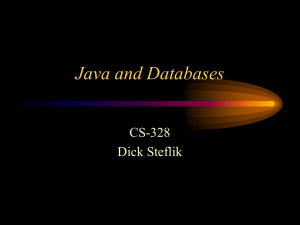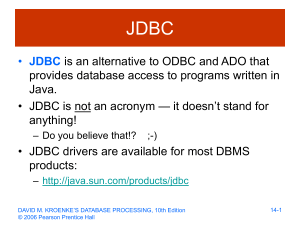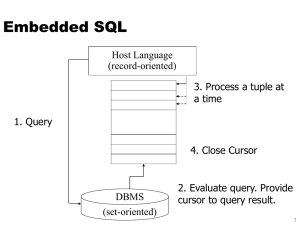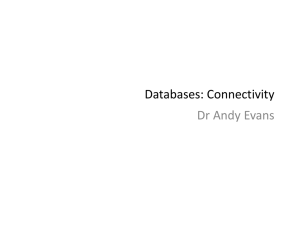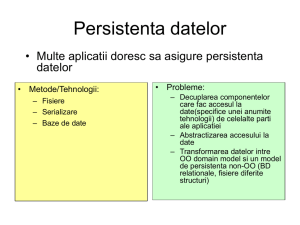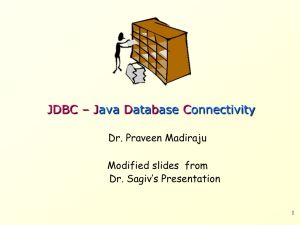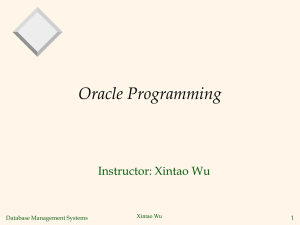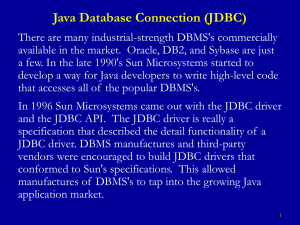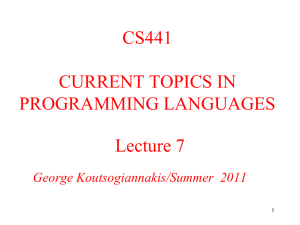Java Database Connectivity (JDBC)
advertisement
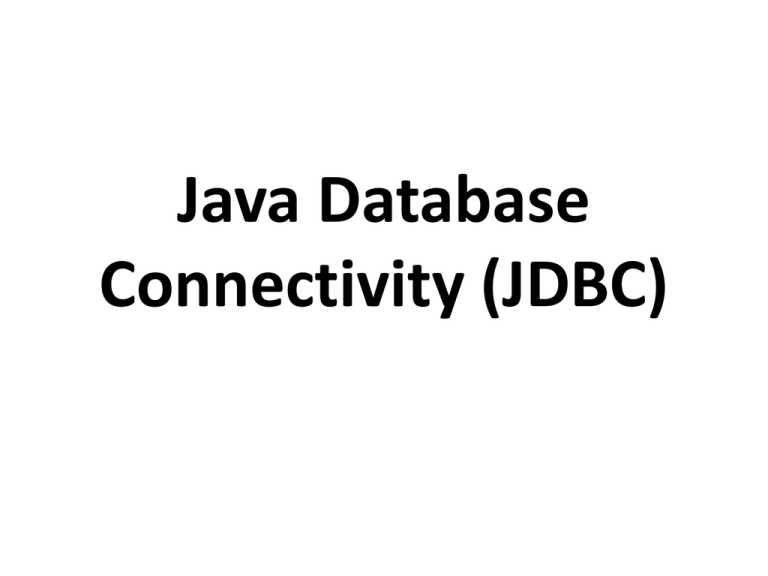
Java Database Connectivity (JDBC) Topics 1. The Vendor Variation Problem 2. SQL and Versions of JDBC 3. Creating an ODBC Data Source 4. Simple Database Access 5. Modifying the Database Contents 6. Transactions 7. Meta Data 8. Using a GUI to Access a Database 9. Scrollable ResultSets in JDBC 2.0 10. Modifying Databases via Java Methods 11. Using the DataSource Interface. Introduction to JDBC • JDBC is used for accessing databases from Java applications • Information is transferred from relations to objects and vice-versa - databases optimized for searching/indexing - objects optimized for engineering/flexibility 3 JDBC Architecture Oracle Driver Oracle Java Application JDBC DB2 Driver DB2 Network MySQL Driver MySQL 4 JDBC Architecture (cont.) Application JDBC Driver • Java code calls JDBC library • JDBC loads a driver • Driver talks to a particular database • An application can work with several databases by using all corresponding drivers • Ideal: can change database engines without changing any application code (not always in practice) What is JDBC? “An API that lets you access virtually any tabular data source from the Java programming language” JDBC Data Access API – JDBC Technology Homepage What’s an API? See J2SE documentation What’s a tabular data source? “… access virtually any data source, from relational databases to spreadsheets and flat files.” JDBC Documentation We’ll focus on accessing Oracle databases 6 General Architecture What design pattern is implied in this architecture? What does it buy for us? Why is this architecture also multi-tiered? 7 8 JDBC JDBC is a Sun trademark It is often taken to stand for Java Database Connectivity Java is very standardized, but there are many versions of SQL JDBC is a means of accessing SQL databases from Java JDBC is a standardized API for use by Java programs JDBC is also a specification for how third-party vendors should write database drivers to access specific SQL versions Driver types There are four types of drivers: JDBC Type 1 Driver -- JDBC/ODBC Bridge drivers ODBC (Open DataBase Connectivity) is a standard software API designed to be independent of specific programming languages Sun provides a JDBC/ODBC implementation JDBC Type 2 Driver -- use platform-specific APIs for data access JDBC Type 3 Driver -- 100% Java, use a net protocol to access a remote listener and map calls into vendor-specific calls JDBC Type 4 Driver -- 100% Java Most efficient of all driver types Why JDBC drivers? • To cope with the variation in internal format of databases from vendor to vendor • JDBC drivers are some mediating software that allow JDBC to communicate with the vendor-specific API for that database. • For information about JDBC drivers form specific databases, visit http://servlet.java.sun.com/products/jdbc/drivers. Sun’s JDBC-ODBC driver for MS-databases • Microsoft's ODBC drivers were originally available only for Microsoft (MS) databases • Sun’s JDBC-ODBC bridge driver is for MS-databases • It is in package sun.jdbc.odbc, which is included in the J2SE • JDBC-ODBC driver converts the JDBC protocol into the corresponding ODBC one SQL and Versions of JDBC Versions of JDBC • JDBC 1.0 with JDK 1.1 • JDBC 2.0 with JDK 1.2 (J2SE 1.2) (commonly used) • • scrolling forwards and backwards in a result set • making updates to database tables using Java methods JDBC 2.1 with J2SE 1.2.2 J2SE 1.3. • • • server-side database manipulation JDBC 3.0 with J2SE 1.4. • Access from spreadsheets and flat files or any data source • Included java.sql and javax.sql JDBC 4.0 with JDK6. java.sql • The package comprising the core JDBC API is called java.sql • We use a simple MS Access database, which means that the inbuilt JDBC-ODBC bridge driver can be employed • If you wish to experiment with other databases, place the appropriate JDBC driver within folder java\jre\lib\ext. Creating an ODBC Data Source Creating an ODBC Data Source 1. First , it is necessary to register the database as an ODBC Data Source. 2. Once this has been done, the database can be referred to by its Data Source Name (DSN). steps to set up your own ODBC Data Source(only for ODBC databases!) Simple Database Access Using JDBC to access a database requires several steps Using JDBC to access a database requires several steps 1.Load the Database Driver • class is used to hold methods that operate upon other classes in order to furnish details of their characteristics • forName method of class Using JDBC to access a database requires several steps 2. Establish a Connection to the Database • declare a Connection reference • call static method getConnection of class DriverManager to return a Connection object • Method getConnection takes three String arguments: 1. a URL-style address for the database; 2. a user name; 3. a password. Using JDBC to access a database requires several steps 2. Establish a Connection to the Database Address format: jdbc:<sub-protocol>:<data-source> • <sub-protocol> specifies a database connection service (i.e., a driver) • <data-source> provides all the information needed by the service to locate the database Using JDBC to access a database requires several steps 2. Establish a Connection to the Database Assuming that our Finances database is indeed local and that we did not set a user name or password for this database If this same database were remote Using JDBC to access a database requires several steps 3. Create a Statement Object and Store its Reference • Call createStatement () method of our Connection object • Save the address of the object returned in a Statement reference. Using JDBC to access a database requires several steps 4. Run a Query/Update and Accept the Result(s) • Class Statement has methods to execute queries: 1. executeQuery () to retrieve data from a database 2. executeUpdate() to change the contents of the database • The former method returns a ResultSet object, • latter returns an integer that indicates the number of database rows that have been affected by the updating operation. Using JDBC to access a database requires several steps 4. Run a Query/Update and Accept the Result(s) Using JDBC to access a database requires several steps 4. Run a Query/Update and Accept the Result(s) Using JDBC to access a database requires several steps 5. Manipulate/Display/Check Result(s) • The only method of ResultSet that we need to make use of at present is next, which moves the ResultSet cursor/pointer to the next row in the set of rows referred to by that object. • We can retrieve data via either the field name or the field position using the appropriate method 5. Manipulate/Display/Check Result(s) 5. Manipulate/Display/Check Result(s) 6. Repeat Steps 4 and 5 as Required 7.Close the Connection Modifying the Database Contents Modifying the Database Contents • Database Update Statements : • • • • INSERT DELETE UPDATE Update statements are submitted via the executeUpdate() method of statement interface Modifying the Database Contents Example: Example: Example: Example: Example: Example: Example: Transactions Transactions • one or more SQL statements that may be grouped together as a single processing entity • We want either all the statements or none of them to be executed. • Java provides the Connection interface methods 1. commit used at the end of a transaction to commit/finalise the database changes 2. rollback used to restore the database to the state it was in prior to the current transaction Transactions • By default, JDBC automatically commits each individual SQL statement that is applied to a database. • In order to change this default behaviour so that transaction processing may be carried out, we must first execute Connection method setAutoCommit with an argument of false • We can then use methods commit and rollback to effect transaction processing. Transactions Meta Data Meta Data • 'data about data‘ • Two categories of meta data available through the JDBC API: • data about the rows and columns returned by a query (i.e., data about ResultSet objects); • data about the database as a whole. The first of these is provided by interface ResultSetMetaData, an object of which is returned by the ResultSet method getMetaData Meta Data • data about the rows and columns is provided by interface ResultSetMetaData, an object of which is returned by the ResultSet method getMetaData • Data about the database as a whole is provided by interface DatabaseMetaData, an object of which is returned by the Connection method getMetaData Meta Data • Information available from a ResultSetMetaData object includes the following: • the number of fields/columns in a ResultSet object; • the name of a specified field; • the data type of a field; • the maximum width of a field; • the table to which a field belongs. Meta Data • SQL types is represented in class java.sql.Types INTEGER and VARCHAR are particularly commonplace, the latter of these corresponding to string values. Meta Data • The example coming up makes use of the following ResultSetMetaData methods, which return properties of the database fields held in a ResultSetMetaData object. Meta Data Meta Data Meta Data Meta Data Meta Data Meta Data Meta Data Meta Data Scrollable ResultSets in JDBC 2 Scrollable ResultSets in JDBC 2 With the emergence of JDBC 2 in Java 2, however, a great deal more flexibility was made available to Java programmers by the introduction of the following ResultSet methods: Scrollable ResultSets in JDBC 2 • results.relative(-3); //Move back 3 rows. • results.absolute(3); // Move to row 3 (from start of ResultSet). • An overloaded form of the Connection method createStatement is used to create scrollable ResultSets. This method that takes two integer arguments. Scrollable ResultSets in JDBC 2 • There are three possible values that <resultSetType> can take: • TYPE_SCROLL_SENSITIVE causes any changes made to the data rows to be reflected dynamically in the ResultSet object, while TYPE_SCROLL_INSENSITIVE does not. Scrollable ResultSets in JDBC 2 • <resultSetConcurrency> can take two possible values the first means that we cannot make changes to the ResultSet rows, while the second will allow changes to be made Scrollable ResultSets in JDBC 2 Scrollable ResultSets in JDBC 2 Scrollable ResultSets in JDBC 2 Scrollable ResultSets in JDBC 2 Scrollable ResultSets in JDBC 2 Scrollable ResultSets in JDBC 2 Scrollable ResultSets in JDBC 2 Scrollable ResultSets in JDBC 2 Modifying Databases via Java Methods Modifying Databases via Java Methods • With of JDBC 2 we can modify ResultSet rows directly via Java methods • Without having to send SQL statements • the changes reflected in the database itself! To do this: 1. use the second version of createStatement 2. supply ResultSet.CONCUR_UPDATABLE as the second argument. Modifying Databases via Java Methods • The updateable ResultSet object does not have to be scrollable Modifying Databases via Java Methods • A set of updateXXX methods are used to update database. • Each of these methods takes two arguments: • a string specifying the name of the field to be updated; • a value of the appropriate type that is to be assigned to the field 1. Updating There are three steps involved in the process of updating: 2. Insertion For an insertion, the new row is initially stored within a special buffer called the 'insertion row' and there are three steps involved in the process: 2. Insertion 3. Delete Example : Sample Output
